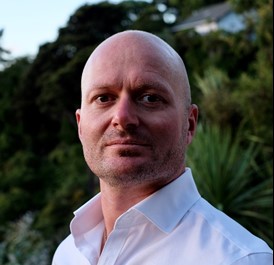
The financial sector is constantly innovating and finding ways to use technology to better optimise its processes and services.
Digital banks and FinTech are some of the upcoming financial institutions with pools of innovative efforts under their wing. The challenge for traditional structures such as central banks is to continue ensuring that its services meet customer demands while also embracing innovation.

We had the opportunity to interview Sam Allen, Manager, Digital Strategy (CTO), Reserve Bank of New Zealand (RBNZ), to understand more the processes and decisions behind this drive.
As New Zealand’s central bank, RBNZ is responsible for setting monetary policy to maintain price stability and promoting the maintenance of a sound and efficient financial system.
Sam is directly responsible for setting the technology direction of the organisation and ensuring a well-planned approach for its delivery.
His role includes executing the data strategy, to see RBNZ become the first central bank with its core data and analytics capability being public cloud based.
Prior to this he worked with HSBC on their global digital transformation program, moving from a bricks and mortar to digital bank and Credit Suisse building their Rates business global trading system.
Banks on Cloud Services
Just like many other organisations, RBNZ employs cloud computing for storing data and for conducting data analysis. Sam shared his views on the main benefits of it:
1. Efficiency through micro-level cost management
2. Data Security
3. On-demand / Immediate scalability for storage or compute
4. Mobility
5. Disaster recovery
6. Lowering the cost of curiosity
“Cloud supported data platforms are no silver bullet,” said Sam. He explained that the benefits brought with cloud technology could act as a double-edged sword, bringing about high-risk areas to an organisation.
It is imperative that cloud platforms are executed and managed well to avoid losses such as in the cases of data breaches. If maintained well, organisations can realise the benefits associated with on-demand storage and scalable computing power.
When moving data storage and analysis services capabilities to a cloud vendor, organisations need to note cloud providers generally only offer a platform. The onus remains on the businesses to invest more heavily in internal skillsets related to tool integration and platform management, rather than building and supporting the more common in-house application. There are options to negate this, such as buying managed analytics capabilities.
An insight-driven business means better customer relationships, a more seamless customer experience, better and faster product iteration, and a focus on actionable data.
More data does not mean more useful insights; knowing how to use that data effectively is where the skill lies. Understanding the data at hand provides the ability to derive valuable insights and trends. In the case of a central bank, it will aid in monetary policy setting and more efficient supervision and governance.
This doesn’t mean that those don’t exist without a cloud data platform. It is the cost/benefit realisation differential when looking at the scale of data access, compute and tooling to generate those insights in a timely actionable manner at scale, while balancing security and costs changes the operating model and corporate decision-making processes.
Ensuring Cyber-Resilience
Sam acknowledged that privacy and security are common concerns across all organisations. As a central bank, RBNZ relies more on the reputational costs of data loss.
As with most New Zealand government agencies, RBNZ is subject to the Official Information Act (OIA). The OIA provisions for members of the public to request access to any non-sensitive data held by a government agency. This puts RBNZ in a unique position.
Sam said that the bank does not hold personably identifiable information (PII) and most of the data is rolled up to a higher level. This provides a level of obfuscation which means that even if they did lose data to a breach, it isn’t that useful to hackers looking for saleable or leverageable data.
The way in which RBNZ has approached cloud to store data also provides a barrier and assurance. RBNZ does not hold their systems of record on public cloud. As careful custodians of their data sources, RBNZ only shifts into the public cloud data that is required to support their analytics capabilities. Sam added that reducing possible exposure breadth whilst maintaining usability is paramount.
He said there’s lot of time and money being spent to ensure that the Bank has strong privacy and security controls across every aspect of its platform. It is a priority to ensure that it is being the best custodian of information.
Actions for mitigating risks surrounding privacy and security
A lot of time is invested into looking at the Bank’s architecture, the tooling along with the data being used. Together they form the view on how much review time is needed. The riskier the data, or open the tooling, the greater the need for more scrutiny and time spent on assurance. Sam shared that the Bank’s initial architecture for a data analytics platform had Athena as the query tool. It was quick, cheap, well-supported and seemed ideal for integration for end users.
They realised when implementing the solution that Athena’s private endpoints could not be locked down. This led them to find a secure solution which ensured the same outcome. In changing technologies, they increased operating costs by up to 10x.
Sam stressed the importance of having the right people ask the right questions and being bold enough to challenge assumptions, in order to mitigate risks in an ongoing basis. He shared that the business was happy to support this cost uplift as it assured a higher security model.
RBNZ’s platform has internal security reviews, external pen tests, and also has had security and architectural reviews by reputable agencies. The components and setup were shared among trusted government agencies to get peer review on selection choices.
Strong management of the AWS NACLS, ensuring encryption in transit and at rest, closely managing firewall rules, consolidating virtual private clouds and ensuring active monitoring across the platform are but a few of the risk mitigants RBNZ employ.
“No doubt, it is an ongoing and evolving area that needs constant attention,” said Sam. “As technology and services change, so do their potential holes and risks.”
He stressed that RBNZ does not only carry risks but also the impact of being the first central bank to deliver at scale a data and analytics platform in public cloud.
“If we get it right, it sets a strong precedent as a model others can follow,” he added.
Technologies employed for optimising processes/improving customer experiences
People were stressed as the most important form of technology for improving customer experience. Sam said that without a doubt, humans are a unique technology that can never be lost to improving customer experience.
With automated collection tooling, CRMs or interactive applications, he said that their most powerful tool is still the interactions RBNZ staff have with the financial industry.
FinTech and banks
Sam defined FinTech as “simply a technology used to support or enable banking and financial services”.
“Fintech 1.0 is believed to be from 1886. An era when we first started talking about financial globalization. It began with technological advancements such as the telegraph, which enabled the rapid transmission of financial information across borders for the first time,” he added.
Technology today enables fast communication and automated decision making while continuing to support and expand capabilities of all financial institutions. Real-time processing of transactions, blockchain-enabled contracts or immediate card blocking via a smartphone app are some of such capabilities.
Technology underpins the growth of banks and their capabilities, improving engagement both within their walls and externally with customers and fellow regulators.
At RBNZ, Sam said that robust technology systems underpin how the bank is maintaining New Zealand’s monetary system sound, efficient and dynamic. Newer technologies offer opportunities for increasing their effectiveness as a central bank.
RBNZ utilises a lot of datasets to help inform and manage its operations. It leverages on Fintech capabilities, such as cloud technologies to support its capability growth, which has allowed them to increase their compute and storage to uplift data analytics and improve their capability to assure New Zealand’s fiscal economy.
“We’re interested in game-changers to keep us ahead of potential disruption and we are always looking to improve how we can best serve New Zealand through our day-to-day operations,” he said.
Without a doubt, the adoption of FinTech improves competition in the marketplace, ensuring more extensive opportunities for customers to get better potential outcomes from their current institutions. It is not how ever a wholesale replacement of banks on the high street.
Sam said that some large banks have doubled down on technology-lead customer interactions, on the premise of it being quicker, cheaper per engagement and more convenient.
He stressed that successful banks are not being replaced by FinTech, instead they find the best medium of human and non-human interactions to offer the right engagement to their customers. Building a brand and successful business model through increasing their branches and human engagement, while also employing FinTech to ensure a great customer, technology, experience seems to be a winning model.
Future tech and innovation plans of RBNZ
“We are at a pivotal point in the history of the Reserve Bank of New Zealand,” said Sam. The Bank is undergoing significant changes – both culturally as an institution and with the government’s expectations of their performance as a central bank. They continue to build their capability to respond to, lead and influence their rapidly changing environment.
In its latest Statement of Intent (SOI), RBNZ set out its vision to being a Great Team and the Best Central Bank. To get there, RBNZ recognises it needs to review the way it operates, engages and delivers its core responsibilities.
This includes operating to the extent of its legislative mandate, taking a long-term view on all policy work, embracing innovation and inclusiveness, and being influential on the broader challenges that affect the people of New Zealand.
Its core mandate, enshrined in its statute, is to promote the prosperity and wellbeing of New Zealanders, and contribute to a sustainable and productive economy.
In line with this, Sam shared that the Bank has just completed its future state architecture review which has produced promising outlook. Improved digital workspace capabilities to engage with the public and those under supervision are to be implemented as well.
The Bank intends to have a richer tracking of the New Zealand dollar throughout the economy and enable cloud-based modelling to better forecast the impact of climate change on the key factors driving the economy.
It also aims to lower the cost of curiosity with the data and models it holds through enabling community access to the Bank’s data analytics platform and so much more.
Sam enforced on the importance of innovation for the bank, “Technology is a strong investment area, which will continue to grow the capability of the bank and enable us to do more for New Zealanders.”


















